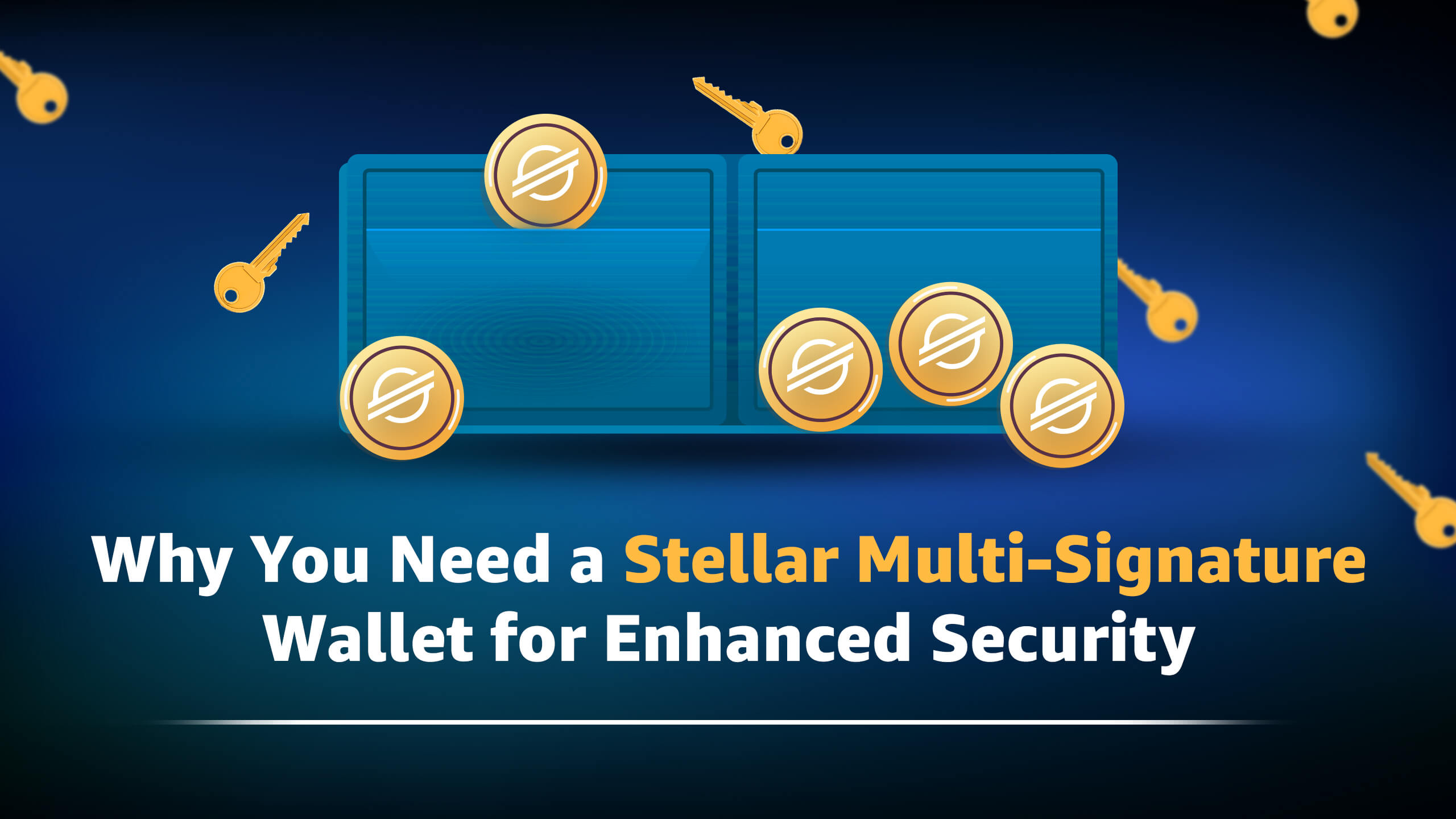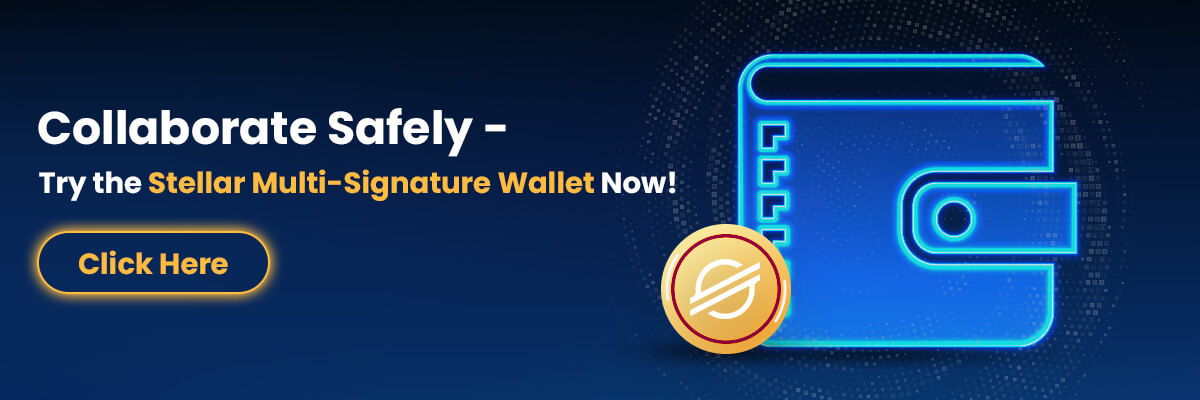The Stellar global network has gained immense popularity and stardom in recent years, owing to its inherent capabilities of financial inclusions and cross-border transactions. Its anchors behave as the bridge between the on-chain tokens and the off-chain financial banking rails, thereby amalgamating the goodness of both centralized and decentralized finances together on the same platform. What’s more, the Stellar global network comes with built-in tools, APIs, and SDKs to allow developers to build high-class DApps, including wallets, exchange platforms, and many more. However, recently, there have been several concerns about wallet security that operate on the Stellar global network, even though most wallets are non-custodial, meaning complete encryption of the private keys from the external world.
Usually, the major concern that has been raised is against the dependency on a single digital signature for the verification of the transaction and its further execution. It is not possible to prevent transaction execution solely based on the authenticity of the signature once it is verified to be true. In other words, only a single person needs to give the green light to exchange the crypto tokens. As a result, the functional behavior and scope of the wallet remain under the sole control of a single person, which can pose a significant security threat to several confidential transactions. This is where the concept of a Stellar multi signature wallet comes into the picture!
What is a Stellar Multi Signature Wallet?
A conventional Stellar wallet will need a single private key signature to authenticate and initiate the crypto transaction. Once the account holder validates his private key, he authorizes the transaction, which can involve purchasing, selling, or exchanging the crypto token on the Stellar blockchain. However, in such cases, the authority rests with a single user, which can introduce significant security issues. It happens especially in organizations and teams where asset ownership or token control is distributed amongst multiple users. To facilitate smooth transactions and streamline the process of decentralized finances, a Stellar multi signature wallet is used.
As the name implies, such wallets will require private key holdings from multiple users who are in control of a certain tokenized asset or the total cryptocurrency holding. Any transaction initiated through these wallets will require at least two digital signatures for further execution. If not, it will be stalled from any further activity until and unless all the involved parties authenticate and validate their private key holdings. Multisig wallets can also be used by individual members who have wallets with at least two private key pairs.
What is the Threshold Signature Scheme in the Stellar Network?
To enhance wallet security and ensure the multi signature infrastructure works appropriately, the Threshold Signature Scheme is often integrated with the underlying software architecture. A threshold limit defines the signature weight required for initiating a crypto transaction through the wallet. Its direct use is associated with transaction authorization, where the weights of all the signatures are added up and compared with the defined threshold. If the sum value is equal to or more than the threshold value, the transaction gets authorized and further execution commences.
For example, let’s say the defined threshold signatures of a Stellar wallet are 10, and the weight of each participating private key is 2. This means that five users will have to validate their private keys to authorize the initiated transaction. However, if the total sum of the private key weight is determined to be 8, the transaction won’t be granted since it is less than the pre-defined wallet threshold. Similarly, if the total number of signatures is more than the defined threshold, the transaction will fail, regardless of whether the provided signatures are valid or not.
Hence, it’s important to ensure the number of multiple signatures associated with the Stellar wallet matches the threshold limit for the transaction to get authorized.
How Stellar Multi Signature Wallets Can Be Used in Real-Time Scenarios?
There is no doubt that the Multisig infrastructure can easily enhance wallet security and prevent burdening a single user with the sole control of transaction authorization. To help you understand the concept further, we have explained the four major ways in which Multisig wallets can be used in real-life scenarios.
1. Anchors
When you want to run an anchor for crediting crypto tokens or fiat currency to another account, you use the issuing key for the authentication. However, it might expose the master key to external vulnerabilities, and someone else might start using the same with malicious intent. To prevent this from happening, you can add another signing private key to the anchor account, ensuring its weight is below the medium threshold value. This way, the additional key can be used for authenticating the credit account but not for making any payment.
2. Expense Accounts
Another way in which you can use the Stellar multi signature wallet is for an expense account. Let’s say you want to be in sole control of all the allowable operations, which is why you should possess the master key weighting 3. You add two more users, each with a signing key of weight 1, meaning they will be allowed to initiate any expense transaction from the Multisig wallet. However, if you want to change the number of user holdings, only you will be able to do so since your master key weight matches the high threshold of the concerned operation.
3. Joint Accounts
When you want to open a joint account wallet on the Stellar blockchain, you can leverage the Multisig architecture. Here, you, being the principal holder, will have the master key. The other participants will have the signing keys necessary to authorize any operation and match the pre-defined threshold. Now, you can define a medium threshold of 0 and a high threshold of 3 for the concerned wallet. It means that for making payments, any of the signing keys will be needed. However, if you want to add any more users to the wallet, it would need approval from all three involved parties to match the high threshold.
4. Company Accounts
For a company account, let’s assume you, being the principal participant, have a master key with a defined weight of 0. It means you won’t be able to initiate any operation or transaction through the multi signature wallet without other participants. Now, you want to add four more employees with signing keys, each weighing 1. The account will have three pre-defined thresholds, low, medium, and high, each with a level of 3. This means that at least three employees out of four will have to provide their private signing keys to authorize any transaction.
What are the key features of the Stellar Multisig wallet?
Although we have discussed the major use cases of the Stellar multi signature wallet, knowing about the DApp’s key feature is imperative. Only then can you make the call on whether you want to distribute the authorization power to multiple users or retain the control within your jurisdiction and governance? Below, we have described the major factors that define a Multisig wallet deployed on the Stellar global network.
1. Customizable Signature Configuration
You can easily configure the weights of different signatures associated with the Multisig wallet. For example, you can set your master signature key to weight 3, while other participating users can have a key weight of 1. It will allow you to handle all the operations through the wallet, regardless of the threshold defined. Such customization level allows the master user to delegate the permissions to other signing users for different wallet operations according to the pre-defined threshold limit.
2. Improved Control Over Wallet Access
When multiple stakeholders are involved in authorizing a transaction, you can leverage the Multisig wallet to control user access. Whether it’s initiating a payment through a crypto fund or managing the token holding against an asset, no single user will have unanimous control over the wallet operations. Rather, the control will be distributed amongst all the participating stakeholders.
3. Enhanced Wallet Security
Multi-signature architecture imparts an additional layer of wallet security in the DeFi ecosystem, allowing users to initiate transactions in a controlled manner. For example, let’s say the signing keys of a wallet are distributed amongst five users. Even if one of the signing keys is compromised or exposed to the external world, no one will be able to gain control over the wallet operations and the fund holding without access to the rest four keys. It also encapsulates the master key, ensuring the issuance power is encrypted and kept private in all senses, especially while running anchors to initiate any crypto transaction on the Stellar global network.
4. Increased Transparency
All the involved stakeholders will have complete visibility of who authorized a transaction through the Stellar multi signature wallet. As a result, there won’t be any conflict among the users, especially when high-volume or confidential operations need to be performed through the concerned wallet. It also helps in preventing any fraudulent activity since all the signatories will be required to authorize any transaction based on the pre-defined threshold and key weightage.
5. Recovery And Backup
Another key feature of the Multisig Stellar wallet is the option for recovering any stolen key. Let’s assume you, being an individual user, have four distributed signing keys. If one of the private key information is lost, you can recover the information from its backup and gain control over the wallet operations and the associated fund holding.
Conclusion
Now that we have illustrated the significance and use cases of the Stellar multi signature wallet, you won’t have to contemplate whether or not to distribute the control amongst multiple users or not. Stellar comes with different SDKs that will allow you to develop a merchant wallet with multiple users having the singing keys and a hidden master key. You can easily configure the threshold limits and the number of keys needed to match the pre-defined threshold and authorize the transaction through the merchant wallet.





